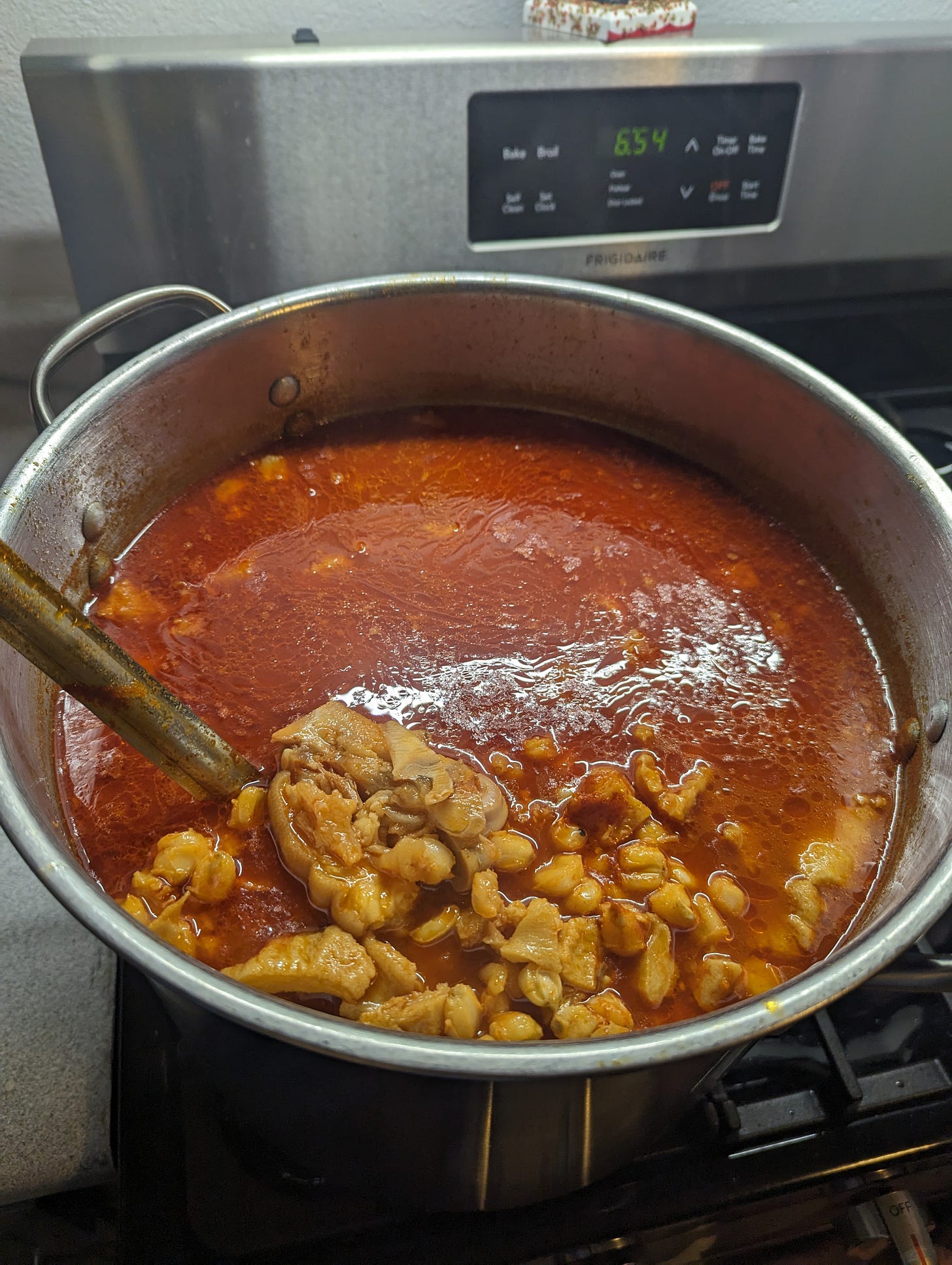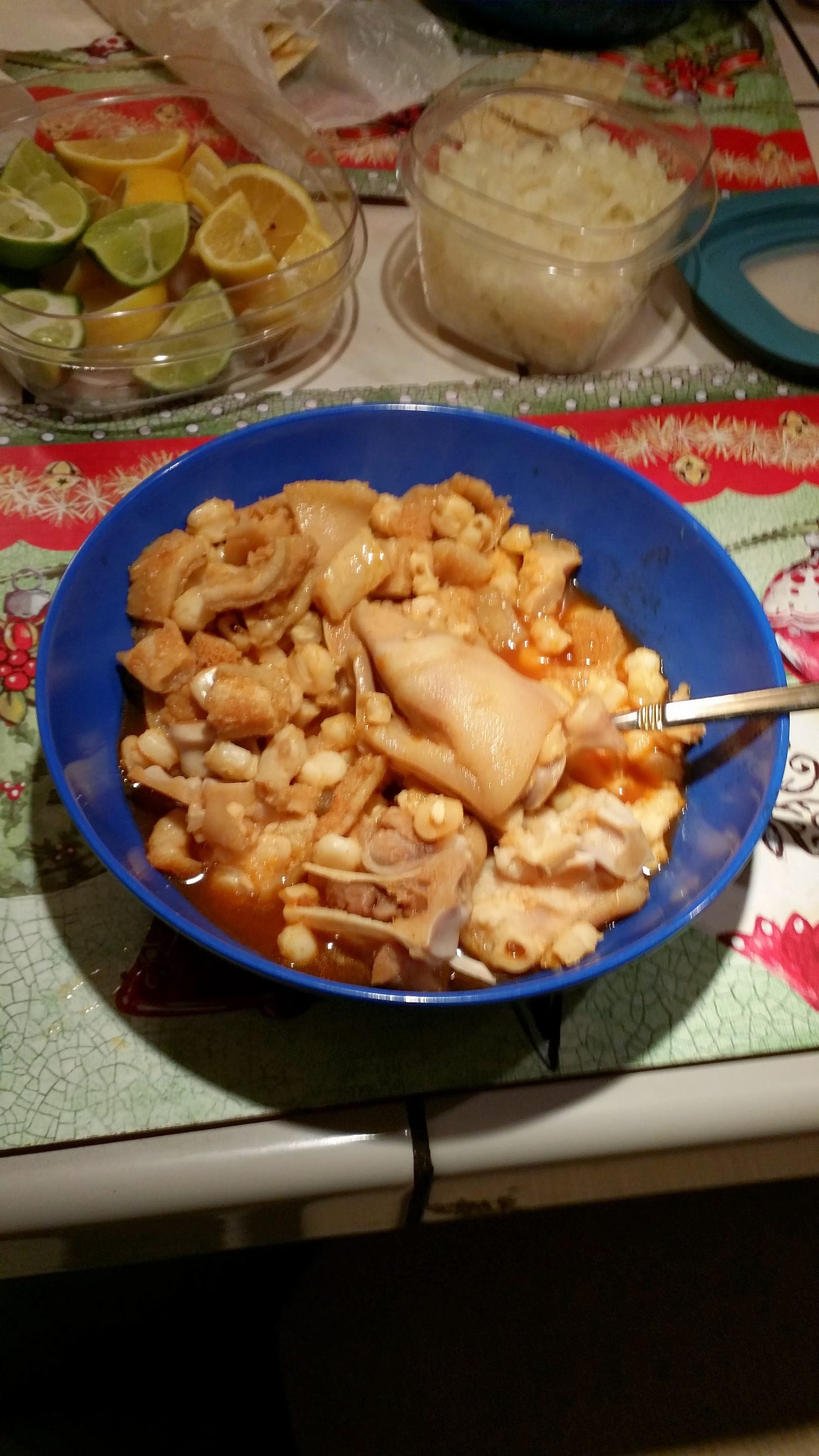Menudo: Passing on a Legacy of Flavor
Exploring the background of this Mexican Soup made with Love
It’s Christmas Eve as I’m writing this. For most us Latinos, that’s basically Christmas. While their will be so many cultural dishes we are getting ready to enjoy this evening like tamales, posole, enchiladas and biscochitos — in my family’s house, it was all about menudo.
We start cooking the menudo the morning of Christmas Eve. It will be ready for a taste this evening at the family party but prime time for it’s flavor will be the next day, just in time for any hangover cures.
For those that don’t know, menudo is a traditional Mexican soup. Staple ingredients are beef tripe (we call it “pansa” which is cow stomach), patas de puerco (pigs feet), hominy, and chile. No one knows the true origins of the dish. Some say Central Mexico and others Northern Mexico. Most research is pretty consistent that it originated after Spanish Colonization when the Spanish brought animals like pork and cows and merged with indigenous recipes and practices which included the corn (hominy) and spices.
There are many regional spins to this dish but holistically, menudo is often enjoyed on special occasions, such as holidays, birthdays or just getting to the weekend. My menudo recipe has a New Mexican flare to it as we only use the red New Mexican chile peppers which is different from the variations I’ve had in Texas, California and Mexico. I like to top mine with oregano, onions, cilantro and lemon/lime. Usually I’ll eat with a corn tortilla but my dad’s preference was crackers.
For me, menudo is more than just another cultural dish
I learned how to cook it from my dad who made sure that I learned as young as I can remember. His mom (my grandma), made sure my dad learned and before that, her parents made sure my grandma learned how to cook it. It’s one of those generational recipes.
I would go with my dad to Hi-Lo market in Albuquerque which was a specialty meat store in the city. Back then, it was one of the few that sold pansa and patas. We’d wake up early Christmas eve, prepare the large pots and spoons that were designated only for menudo, put on Christmas music, our aprons and begin cutting and cleaning everything.
When we finished that evening, that’s when I’d go with my dad to drop off large pots of it to his friends as a gift so they can enjoy a few bowls. We’d finally end the night enjoying a bowl before going to bed and then again in the morning when our family got together again to enjoy the leftover foods.
After my dad passed away 8 years ago, I’ve been the Menudo man around the house (with help from my mom or wife of course). Upon some reflection this year, I wanted to share a few observations about cooking Menudo after years of preparing the dish.
Menudo is steeped in history, served with Love.
When you eat a bowl, you are literally tasing flavors that pre-date the 16th century. It was also known to be “Una sopa del pobre” (soup of the poor) because it fed so many and with a recipe that ensured no part of the animal was wasted since throwing away leftovers was a luxury (as it should be today.)
Additionally, a lot of work goes into preparing menudo. Because of its main ingredients, it’s not a dish to set it and forget it. It takes a lot of time watching, stirring and cleaning. Anyone who tastes menudo is tasting 10+ hours of love being put into a dish.
Menudo Slow’s Down Time
This leads me to my second point. If you are like me, life gets so busy with tons of distractions. This time of the year can also feel overwhelming for many. Because menudo takes so much time and focus, it literally can slow down time for you.
What I really enjoy about cooking menudo is that for one day, I can’t afford to leave the house to run errands or do any work. It requires so much attention that I am forced to sit in peace and just wait as it is cooked — a feeling many of us don’t get anymore.
Menudo “raises the dead”
Menudo is believed to be a hangover cure, which is why it is often served during celebrations like weddings, major holidays or after any night of partying. Some say that’s why it’s mostly served on the weekend at Mexican Restaurants.
According to my grandpa, Menudo was the cure for everything. Anytime someone said they were sick, he would say that all they needed was a bowl of menudo. Essentially, no matter how awful you feel, menudo’s healing power is transformational enough to bring a person’s spirit back to life.
What are your thoughts on menudo? Do you love it or hate it? What do you eat your menudo with?





